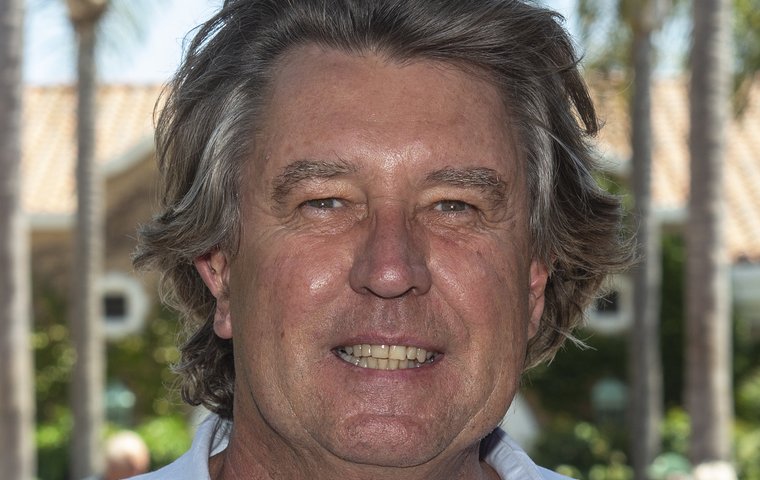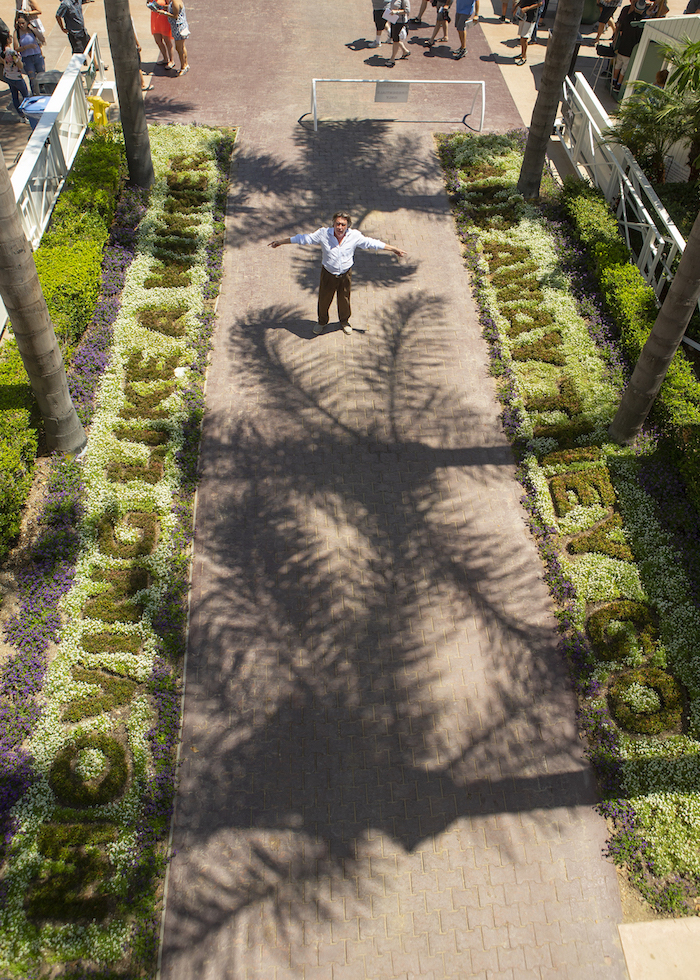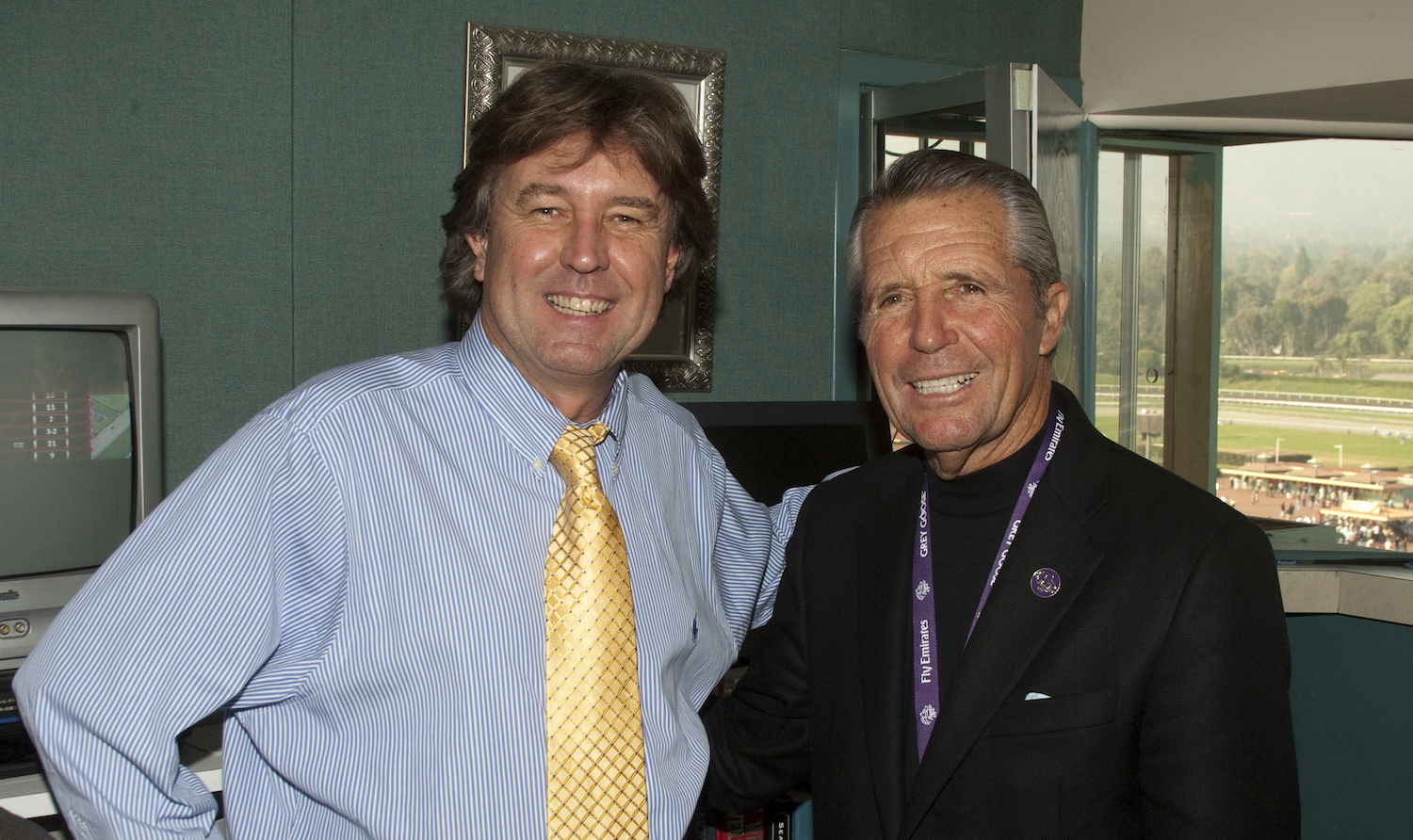
After missing his first Del Mar meet since 1984, Trevor Denman was anxious to get back to his announcer’s booth and its view of the Pacific Ocean in time for the opening of the summer racing season on Friday, July 16.
The Covid-19 pandemic kept Denman and his wife, Robin, isolated at their farm in southeastern Minnesota for the past year, much to the dismay of his legion of fans. But the races at Del Mar went on without him, with only a trickle of spectators in the stands and veteran caller Larry Collmus ably deputizing at the microphone, describing a product relegated to video screens.
Now, with the coast beginning to clear and Southern California’s pandemic restrictions eased, Denman is gearing up for his 37th season as the voice of Del Mar. Restrictions have been lifted on attendance capacity – as they have been at most tracks across the nation – and nothing will say “horse racing is back” like the opening day tones of the announcer’s Americanized South African accent echoing off the seaside bluffs in the distance.
But first, he had to practice. Yes, Trevor Denman had to practice.
“I’ve had long breaks before – seven, eight months – but never close to two years like this,” Denman said. “And it bothered me.”
The last race he called was on closing day of the Del Mar autumn meet, December 1, 2019.
“So I got on TVG and started calling a few races, just to oil the parts,” Denman said. “It’s doing something so totally different than day-to-day communication that I had to get my brain reoriented. My first try, I was very confused. But, after four or five races, it was the same old story, and, after ten races and a couple hours, I was feeling much more comfortable.”
Although memories of specific horses have disappeared in the mists of time, Denman’s recollection of his first Del Mar season remain vivid. Perched above the press box, high above the original grandstand structure built in 1937, the announcer’s booth was an open-air plywood cage that commanded a 180-degree view northward across the hills of Solana Beach.
“At least the weather was perfect,” Denman said. “And the only other person up there was the photo-finish guy. The sound system, though, must have been put in when the track was built. You might as well have shouted through a tin can. But we were all younger then, and nothing really bothered us. Certainly not working six days a week. After Del Mar I’d go on to 16 straight days at the Pomona fair, go out every night and never miss a beat. Now, if I did one of those nights I’d be out for three days.”
 Del Mar is down to a 4-day week to accommodate a chronic Southern California horse investment shortage. This is nothing Denman necessarily welcomes.
Del Mar is down to a 4-day week to accommodate a chronic Southern California horse investment shortage. This is nothing Denman necessarily welcomes.
“Once you’re there and turn your mic on, you’re immediately into it,” Denman said. “You don’t really think beyond what’s in front of you and the energy and concentration required. I will say, though, that leaving home as we do for the summer to come to Del Mar, you might as well get on with it. Working only four days a week leaves a lot of time on your hands.”
Although Del Mar has trended well recently in the size of its fields, at least in the opening weeks of the 7-week meet, they tend to dwindle as the season progresses. Denman is not fond of the trend.
“I’d rather have 12 horses than a 4-horse field,” he said. “You can focus so much better with a larger field. You can’t get up high in the beginning with just four runners, and you go through them 20 times. It becomes a bit futile. The intensity drops off, at least until you get to the top of the stretch.”

The Denman origin story has become part of racing lore. Born in the Johannesburg suburb of Germiston, from a family of British descent, he came to racing as an exercise rider with ambitions of becoming a jockey. Such a dream was not meant to be, but he found a home for his talents in the announcer’s booth at a variety of South African tracks before a chance encounter with Bill Kolberg, a publicist with Santa Anita Park, who was on north-to-south adventure of the African continent.
When it came to pass that Santa Anita was looking for an announcer, Kolberg threw Denman’s name into the mix. He passed his audition, and the rest is history.
In very short order, Denman joined a handful of North American racing personalities for whom it can be said there was before, and then after. Willie Simms and Tod Sloan popularized the short-stirrup American style of race-riding on an international stage. Ben Jones and Calumet Farm proved that classic colts and fillies could be produced with the relentless pace of military aircraft. Jack Van Berg pioneered the national chain store training stable that was taken to even greater heights by Wayne Lukas.
Before Denman, then 31, took the mic in the fall of 1983 during the Oak Tree meet at Santa Anita Park, most racetrack announcers were mired in the traditional style of reporting a snapshot of the field as it reached certain intervals around the track. It was “so-and-so by a length over what’s-his-name by two lengths over this-other-horse” all the way around until one of them finished in front of the others.
A legendary announcer like Joe Hernandez, who served Santa Anita for 37 years, prided himself on a deadpan style that relied on the background tumult from large crowds to supply the drama. Harry Henson, his longtime counterpart at Hollywood Park and then Del Mar, possessed a voice of Thor but rarely strayed from the established standards, except to occasionally identify a gray horse as “the gray”.
The most popular announcers of bygone eras could be easily identified by their vocal instruments: The lilting tenor of New York’s Fred Capossela, Phil Georgeff’s “spinning out of the turn” at Chicago tracks, the reliable Maryland institution that was Dick Woolley. As the value of televised racing increased in the 1970s, Chic Anderson and Dave Johnson were the stars of New York and California, then Tom Durkin emerged in the 1980s with a creatively theatrical style in his Breeders’ Cup calls that paralleled Denman’s transformation of the craft.
It was Denman, however, who dared fellow announcers to analyze the players on the fly. He fashioned himself as a painter of mental pictures for the fans in the stands staring up at tiny TV monitors or peering into the distance, without the benefit of powerful binoculars.
For his off-track audience, Denman’s intent is to provide a soundtrack for the race unfolding on a screen view limited to the whims of camera operators. His calls can raise hopes before half the race has been run or dash them with a deadly honest observation that a horse was being asked early, but not answering.
Denman holds a special place in his announcer’s heart for horses like Precisionist, Bayakoa, Silver Charm, Alysheba, Best Pal, Lava Man, Songbird, Tiznow, and John Henry, who was at the tail end of his career when young Denman came to town. In addition to Del Mar and Santa Anita, Denman had a long association with the LA County Fair meet as well as a brief run at Hollywood Park, as well as stints at Atlantic City, Laurel, and Pimlico.
Denman’s call of Cigar’s journey through the 1995 Hollywood Gold Cup is a prime example of foreseeing an outcome in progress (see video above). Sometimes he would allow himself the luxury of honest surprise, as he did when describing the moment Beholder seized the 2015 Pacific Classic by the throat (see video below). His description of the 1999 Santa Anita Handicap is two minutes of pure tension that is unresolved until one last thrust of Free House and Chris McCarron under the wire.
When asked for his favorite races, of the thousands he has called, two immediately and consistently come to mind.
“Zenyatta would be one, and then Sunday Silence and Easy Goer in the Preakness would be the other,” Denman said. “Those two would be head and shoulders above the rest.”
Denman was on loan to the Maryland Jockey Club in the spring of 1989 when Sunday Silence and Easy Goer brought their Kentucky Derby feud to Baltimore for the 114th Preakness. While Dave Johnson called the race for network TV, Denman did the honors for the Pimlico in-house system, preserving for all time his account of the see-saw battle between the two protagonists. As the two colts locked together at the top of the stretch (see, and listen to, the video below), without breaking stride Denman proclaimed, “And here’s the race we’ve been waiting for!” He was right. Click here to see, and listen to, the race.
Denman’s call of Zenyatta’s victory in the 2009 Breeders’ Cup Classic at Santa Anita ranks with Anderson’s description of Secretariat “moving like an incredible machine” and with Durkin’s “incomparable, invincible, unbeatable Cigar”.
To that point in Zenyatta’s career, having called six of her 13 victories without a defeat, Denman was ready for anything but assumed nothing. He charted Zenyatta’s every step through the first 9 furlongs of the mile-and-a-quarter Classic as she came from far back to thread her way through the large field.
When Mike Smith steered her sharply to the right at the eighth pole for a clear run, Denman delivered a loud warning shot. Then, with nearly a sixteenth of a mile left to run, he dropped any pretense of impartial reportage. In lyrical rhythm with her closing strides, he slowed his cadence and announced to the world, “This – is – un – be – lievable!” (See video below).
The first race on opening day of Del Mar is usually a claiming affair with horses who have never done anything remotely unbelievable. Still, the return of Denman will be welcomed by those happy pilgrims in attendance, and chances are they will give him good reason to offer his traditional cry of “there’s the roar of the crowd” when the gates for that first race open.
“I certainly hope so,” Denman said. “It will be very good to be back.”


